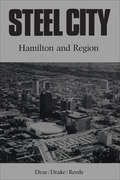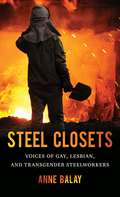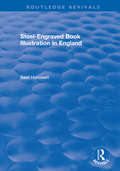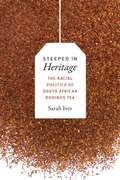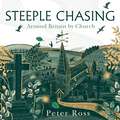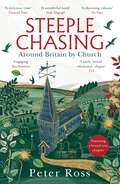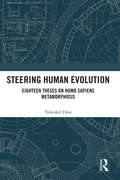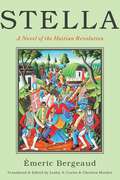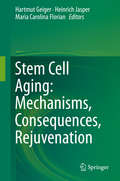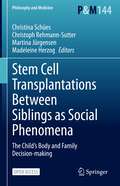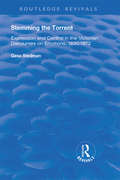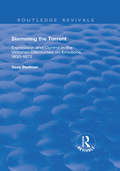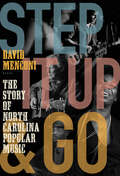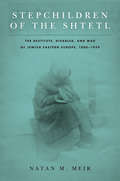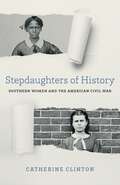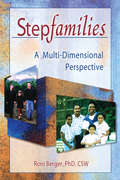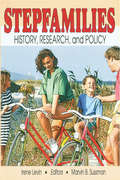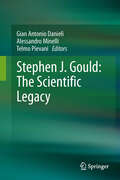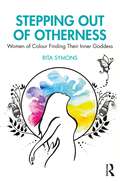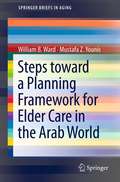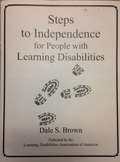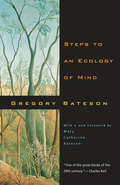- Table View
- List View
Steel City: Hamilton and Region
by J. J. Drake L. G. Reeds M. J. DearFrom its establishment nearly 200 years ago as a village at the centre of an agricultural district, Hamilton has grown into one of Canada's biggest industrial centres, at the heart of a highly developed regional municipality. The story of its changing landscapes, both physical and human, is presented in the nineteen essays that make up this volume, all by geographers associated with Hamilton's McMaster University. Change is the essence of the story. Each contributor focuses on one aspect of the past, present, or future landscapes of Hamilton, and places it within the context of change in the region. The first series of essays explores physical landscapes – geology and relief, climate, soils, vegetation, and hydrology – and shows how human activity has moulded them. The second group charts the evolution of human landscapes in the region, paying special attention to contemporary Hamilton with its rich and diverse combination of people and cultures, and also to the political intrigue that surrounded the introduction of regional government to the area. Finally a third series focuses on the functioning of the Hamilton region. Within a highly complex system, the city and region balance a broad range of often contradictory trends and activities. The contributors examine the difficulties facing agriculture in a rapidly urbanizing region; the importance of Hamilton in caring for welfare-dependent populations; the future of steel in Steel City; the challenges posed by energy requirements in the region; and the hard choices facing policy-makers. The last two essays discuss the role played by McMaster University in the life of the region, and the landscape of Hamilton today: a remarkable complex of historical interest, great natural beauty, and modern city life.
Steel Closets
by Anne BalayEven as substantial legal and social victories are being celebrated within the gay rights movement, much of working-class America still exists outside the current narratives of gay liberation. In Steel Closets, Anne Balay draws on oral history interviews with forty gay, lesbian, and transgender steelworkers, mostly living in northwestern Indiana, to give voice to this previously silent and invisible population. She presents powerful stories of the intersections of work, class, gender, and sexual identity in the dangerous industrial setting of the steel mill. The voices and stories captured by Balay--by turns alarming, heroic, funny, and devastating--challenge contemporary understandings of what it means to be queer and shed light on the incredible homophobia and violence faced by many: nearly all of Balay's narrators remain closeted at work, and many have experienced harassment, violence, or rape. Through the powerful voices of queer steelworkers themselves, Steel Closets provides rich insight into an understudied part of the LGBT population, contributing to a growing body of scholarship that aims to reveal and analyze a broader range of gay life in America.
Steel-Engraved Book Illustration in England (Routledge Revivals)
by Basil HunnisettFirst published in 1980, Steel-Engraved Book Illustration in England is a detailed and comprehensive survey of the steel engravings that were so popular in the nineteenth century. With an extensive range of illustrations, the book refutes the assumption that steel engravings are of little artistic value or importance, a common attitude rooted largely in the connection between steel engravings and mass-produced books. Beginning with an exploration of the identification problems and early history of steel engravings, it moves through the production and printing of the plates and on to a study of several engravers and artists, as well as of the books themselves. Steel-Engraved Book Illustration in England will appeal to anyone interested in the history of printing and illustration.
Steeped in Heritage: The Racial Politics of South African Rooibos Tea
by Sarah Fleming IvesSouth African rooibos tea is a commodity of contrasts. Renowned for its healing properties, the rooibos plant grows in a region defined by the violence of poverty, dispossession, and racism. And while rooibos is hailed as an ecologically indigenous commodity, it is farmed by people who struggle to express “authentic” belonging to the land: Afrikaners, who espouse a “white” African indigeneity, and “coloureds,” who are characterized either as the mixed-race progeny of “extinct” Bushmen or as possessing a false identity, indigenous to nowhere. In Steeped in Heritage Sarah Ives explores how these groups advance alternate claims of indigeneity based on the cultural ownership of an indigenous plant. This heritage-based struggle over rooibos shows how communities negotiate landscapes marked by racial dispossession within an ecosystem imperiled by climate change and precarious social relations in the postapartheid era.
Steeple Chasing: Around Britain by Church
by Peter RossFrom the author of A Tomb With a View - a celebration of the weird and wonderful churches of BritainChurches are all around us. Their steeples remain landmarks in our towns, villages and cities, even as their influence and authority has waned. They contain art and architectural wonders - one huge gallery scattered, like a handful of jewels, across these isles.Award-winning writer Peter Ross sets out to tell their stories, and through them a story of Britain. Join him as he visits the unassuming Norfolk church which contains a disturbing secret, and London's mighty cathedrals with their histories of fire and love. Meet cats and bats, monks and druids, angels of oak and steel.Steeple Chasing, though it sometimes strikes an elegiac note, is a song of praise. It celebrates churches for their beauty and meaning, and for the tales they tell. It is about people as much as place, flesh and bone not just flint and stone. From the painted hells of Surrey to the holy wells of Wales, consider this a travel book . . . with bells on.Praise for Peter Ross'Ross is a wonderfully evocative writer, deftly capturing a sense of place and history, while bringing a deep humanity to his subject. He has written a delightful book.' - The Guardian'Fascinating . . . Ross makes a likeably idiosyncratic guide and one finishes the book feeling strangely optimistic about the inevitable.' - The Observer'A phenomenal, lyrical, beautiful book.' - Frank Turner'The author's humanity has acted as a beacon of light in the darkness.' - The Sunday Times(P) 2023 Headline Publishing Group Ltd
Steeple Chasing: Around Britain by Church
by Peter Ross'What makes Steeple Chasing so compelling - and it is a wonderful book; thoughtful and challenging - ... is Ross's essential kindness, his unfailing empathy with the people he meets on his pilgrimage.' - Daily Telegraph *****'Steeple Chasing is a beautiful and brilliant book; written with such care and deep, abiding interest in its subject matter as to entrance the enthusiast and amateur alike. I loved it.' - Fergus Butler-Gallie'Ross has always had a quiet charm, and it is perhaps displayed best in this book. ' - The Scotsman From the author of A Tomb With a View - Scottish Non-Fiction book of the Year Churches are all around us. Their steeples remain landmarks in our towns, villages and cities, even as their influence and authority has waned. They contain art and architectural wonders - one huge gallery scattered, like a handful of jewels, across these isles.Award-winning writer Peter Ross sets out to tell their stories, and through them a story of Britain. Join him as he visits the unassuming Norfolk church which contains a disturbing secret, and London's mighty cathedrals with their histories of fire and love. Meet cats and bats, monks and druids, angels of oak and steel.Steeple Chasing, though it sometimes strikes an elegiac note, is a song of praise. It celebrates churches for their beauty and meaning, and for the tales they tell. It is about people as much as place, flesh and bone not just flint and stone. From the painted hells of Surrey to the holy wells of Wales, consider this a travel book . . . with bells on.Praise for Peter Ross'Ross is a wonderfully evocative writer, deftly capturing a sense of place and history, while bringing a deep humanity to his subject. He has written a delightful book.' - The Guardian'Fascinating . . . Ross makes a likeably idiosyncratic guide and one finishes the book feeling strangely optimistic about the inevitable.' - The Observer'The author's humanity has acted as a beacon of light in the darkness.' - The Sunday Times
Steeple Chasing: Around Britain by Church
by Peter Ross'What makes Steeple Chasing so compelling - and it is a wonderful book; thoughtful and challenging - is Ross's essential kindness, his unfailing empathy with the people he meets on his pilgrimage.' - Daily Telegraph *****'Steeple Chasing is a beautiful and brilliant book; written with such care and deep, abiding interest in its subject matter as to entrance the enthusiast and amateur alike. I loved it.' - Fergus Butler-Gallie'Ross has always had a quiet charm, and it is perhaps displayed best in this book. ' - The Scotsman From the author of A Tomb With a View - Scottish Non-Fiction book of the Year Churches are all around us. Their steeples remain landmarks in our towns, villages and cities, even as their influence and authority has waned. They contain art and architectural wonders - one huge gallery scattered, like a handful of jewels, across these isles.Award-winning writer Peter Ross sets out to tell their stories, and through them a story of Britain. Join him as he visits the unassuming Norfolk church which contains a disturbing secret, and London's mighty cathedrals with their histories of fire and love. Meet cats and bats, monks and druids, angels of oak and steel.Steeple Chasing, though it sometimes strikes an elegiac note, is a song of praise. It celebrates churches for their beauty and meaning, and for the tales they tell. It is about people as much as place, flesh and bone not just flint and stone. From the painted hells of Surrey to the holy wells of Wales, consider this a travel book . . . with bells on.Praise for Peter Ross'Ross is a wonderfully evocative writer, deftly capturing a sense of place and history, while bringing a deep humanity to his subject. He has written a delightful book.' - The Guardian'Fascinating . . . Ross makes a likeably idiosyncratic guide and one finishes the book feeling strangely optimistic about the inevitable.' - The Observer'The author's humanity has acted as a beacon of light in the darkness.' - The Sunday Times
Steering Human Evolution: Eighteen Theses on Homo Sapiens Metamorphosis
by Yehezkel DrorHumanity must steer its evolution. As human knowledge moves a step ahead of Darwin’s theories, this book presents the emergence of human-made meta-evolution shaping our alternative futures. This novel process poses fateful challenges to humanity, which require regulation of emerging science and technology which may endanger the future of our species. However, to do so successfully, a novel ‘humanity-craft’ has to be developed; main ideologies and institutions need redesign; national sovereignty has to be limited; a decisive global regime becomes essential; some revaluation of widely accepted norms becomes essential; and a novel type of political leader, based on merit in addition to public support, is urgently needed. Taking into account the strength of nationalism and vested interests, it may well be that only catastrophes will teach humanity to metamorphose into a novel epoch without too high transition costs. But initial steps, such as United Nation reforms, are urgent in order to contain calamities and may soon become feasible. Being both interdisciplinary and based on personal experience of the author, this book adds up to a novel paradigm on steering human evolution. It will be of great interest to scholars and researchers of modern history, evolution sciences, future studies, political science, philosophy of action, and science and technology. It will also be of wide appeal to the general reader anxious about the future of life on Earth. Comments on the Corona pandemic add to the book’s concrete significance.
Stella: A Novel of the Haitian Revolution (America and the Long 19th Century #17)
by Emeric BergeaudStella, first published in 1859, is an imaginative retelling of Haiti’s fight for independence from slavery and French colonialism. Set during the years of the Haitian Revolution (1791-1804), Stella tells the story of two brothers, Romulus and Remus, who help transform their homeland from the French colony of Saint-Domingue to the independent republic of Haiti. Inspired by the sacrifice of their African mother Marie and Stella, the spirit of Liberty, Romulus and Remus must learn to work together to found a new country based on the principles of freedom and equality. This new translation and critical edition of Émeric Bergeaud’s allegorical novel makes Stella available to English-speaking audiences for the first time. Considered the first novel written by a Haitian, Stella tells of the devastation and deprivation that colonialism and slavery wrought upon Bergeaud’s homeland. Unique among nineteenth-century accounts, Stella gives a pro-Haitian version of the Haitian Revolution, a bloody but just struggle that emancipated a people, and it charges future generations with remembering the sacrifices and glory of their victory. Bergeaud's novel demonstrates that the Haitians—not the French—are the true inheritors of the French Revolution, and that Haiti is the realization of its republican ideals. At a time in which Haitian Studies is becoming increasingly important within the English-speaking world, this edition calls attention to the rich though under-examined world of nineteenth-century Haiti.
Stellar Transformations: Movie Stars of the 2010s (Star Decades: American Culture/American Cinema)
by Cynthia Baron David Greven Steven Rybin Celestino Deleyto Daniel Varndell Karen Hollinger Kyle Stevens Jennifer O'Meara Brenda Austin-Smith Rick Warner Danielle E. Williams Matt ConnollyStellar Transformations: Movie Stars of the 2010s circles around questions of stardom, performance, and their cultural contexts in ways that remind us of the alluring magic of stars while also bringing to the fore the changing ways in which viewers engaged with them during the last decade. A salient idea that guides much of the collection is the one of transformation, expressed in these pages as the way in which post-millennial movie stars are in one way or another reshaping ideas of performance and star presence, either through the self-conscious revision of aspects of their own personas or in redirecting or progressing some earlier aspect of the culture. Including a diverse lineup of stars such as Oscar Isaac, Kristen Stewart, Tilda Swinton, and Tyler Perry, the chapters in Stellar Transformations paint the portrait of the meaning of star images during the complex decade of the 2010s, and in doing so will offer useful case studies for scholars and students engaged in the study of stardom, celebrity, and performance in cinema.
Stem Cell Aging: Mechanisms, Consequences, Rejuvenation
by Hartmut Geiger Heinrich Jasper Maria Carolina FlorianAging of somatic stem cells reduces cell function and results in dysfunctional organs and tissues, making it an underlying cause of diseases associated with aging. It might even be the primary cause for age-associated attrition of tissue function in organs that heavily rely on stem cells for maintaining homeostasis, like the skin, blood and intestines. Understanding the molecular and cellular mechanisms involved is critical for developing approaches to attenuate stem cell aging and could pave the way for improved quality of life among the elderly. Written by highly prominent experts in the field, this book presents the current state of knowledge on these mechanisms. It offers insights into stem cell function, explains in detail the mechanisms of stem cell aging in model organisms as well as mammalian systems and describes related diseases and approaches to attenuating stem cell aging or achieving rejuvenation. The book is intended for all scientists and clinicians working with stem cells, aging mechanisms or age-related diseases.
Stem Cell Transplantations Between Siblings as Social Phenomena: The Child’s Body and Family Decision-making (Philosophy and Medicine #144)
by Christoph Rehmann-Sutter Christina Schües Martina Jürgensen Madeleine HerzogThis open access book offers insights in short- and long-term experiences from families with bone marrow transplantations between minor siblings. It is based on the first extended qualitative study with 17 families about experiences with recent transplants and experiences with transplants up to 20 years in the past. It covers reflections of donors, recipients and other family members, as well as family interactions. Transplantation of bone marrow from one sibling to another who is ill with a blood cancer (such as Leukemia) is a life-saving therapy. Young children however are not in a position to give consent themselves. How should they be adequately included, depending to their age? Which ethical questions are raised for the parents both at the time of treatment and afterwards, and for the medical professionals in clinical and regulatory contexts? For an in-depth discussion of the findings the books brings together a group of leading scholars from the fields of bioethics, family sociology and philosophy of medicine.
Stemming the Torrent: Expression and Control in the Victorian Discourses on Emotion, 1830-1872 (Routledge Revivals Ser.)
by Gesa StedmanThis title was first published in 2002: Gesa Stedman mines the vein of emotion in Victorian writing to unearth new insights into the ways literature responded to the dramatic social and political changes then taking place. Contemporary research from various disciplines, including sociology, ethnology and history, inform this study, which juxtaposes canonical material such as Dickens' "Hard Times", Charlotte Bronte's "Shirley" and Germaine de Stael's "Corinne" with popular novels and non-fictional texts, such as "The Education of the Heart" by Sarah Ellis and Darwin's "On the Expression of the Emotions in Man and Animals". The analysis deals with emotions applying to both genders, but includes a special section examining the representation of emotion in relation to women. The book aims to provide new insight into the literature of the period, and brings to light new material for scholars interested in the philosophy and psychology of emotions.
Stemming the Torrent: Expression and Control in the Victorian Discourses on Emotion, 1830-1872 (Routledge Revivals)
by Gesa StedmanThis title was first published in 2002: Gesa Stedman mines the vein of emotion in Victorian writing to unearth new insights into the ways literature responded to the dramatic social and political changes then taking place. Contemporary research from various disciplines, including sociology, ethnology and history, inform this study, which juxtaposes canonical material such as Dickens' "Hard Times", Charlotte Bronte's "Shirley" and Germaine de Stael's "Corinne" with popular novels and non-fictional texts, such as "The Education of the Heart" by Sarah Ellis and Darwin's "On the Expression of the Emotions in Man and Animals". The analysis deals with emotions applying to both genders, but includes a special section examining the representation of emotion in relation to women. The book aims to provide new insight into the literature of the period, and brings to light new material for scholars interested in the philosophy and psychology of emotions.
Step It Up and Go: The Story of North Carolina Popular Music, from Blind Boy Fuller and Doc Watson to Nina Simone and Superchunk
by David MenconiThis book is a love letter to the artists, scenes, and sounds defining North Carolina's extraordinary contributions to American popular music. David Menconi spent three decades immersed in the state's music, where traditions run deep but the energy expands in countless directions. Menconi shows how working-class roots and rebellion tie North Carolina's Piedmont blues, jazz, and bluegrass to beach music, rock, hip-hop, and more. From mill towns and mountain coves to college-town clubs and the stage of American Idol, Blind Boy Fuller and Doc Watson to Nina Simone and Superchunk, Step It Up and Go celebrates homegrown music just as essential to the state as barbecue and basketball.Spanning a century of history from the dawn of recorded music to the present, and with sidebars and photos that help reveal the many-splendored glory of North Carolina's sonic landscape, this is a must-read for every music lover.
Stepchildren of the Shtetl: The Destitute, Disabled, and Mad of Jewish Eastern Europe, 1800-1939 (Stanford Studies in Jewish History and Culture)
by Natan M. MeirMemoirs of Jewish life in the east European shtetl often recall the hekdesh (town poorhouse) and its residents: beggars, madmen and madwomen, disabled people, and poor orphans. Stepchildren of the Shtetl tells the story of these marginalized figures from the dawn of modernity to the eve of the Holocaust. Combining archival research with analysis of literary, cultural, and religious texts, Natan M. Meir recovers the lived experience of Jewish society's outcasts and reveals the central role that they came to play in the drama of modernization. Those on the margins were often made to bear the burden of the nation as a whole, whether as scapegoats in moments of crisis or as symbols of degeneration, ripe for transformation by reformers, philanthropists, and nationalists. Shining a light into the darkest corners of Jewish society in eastern Europe—from the often squalid poorhouse of the shtetl to the slums and insane asylums of Warsaw and Odessa, from the conscription of poor orphans during the reign of Nicholas I to the cholera wedding, a magical ritual in which an epidemic was halted by marrying outcasts to each other in the town cemetery—Stepchildren of the Shtetl reconsiders the place of the lowliest members of an already stigmatized minority.
Stepdaughters of History: Southern Women and the American Civil War (Walter Lynwood Fleming Lectures in Southern History)
by Catherine ClintonIn Stepdaughters of History, noted scholar Catherine Clinton reflects on the roles of women as historical actors within the field of Civil War studies and examines the ways in which historians have redefined female wartime participation. Clinton contends that despite the recent attention, white and black women’s contributions remain shrouded in myth and sidelined in traditional historical narratives. Her work tackles some of these well-worn assumptions, dismantling prevailing attitudes that consign women to the footnotes of Civil War texts.Clinton highlights some of the debates, led by emerging and established Civil War scholars, which seek to demolish demeaning and limiting stereotypes of southern women as simpering belles, stoic Mammies, Rebel spitfires, or sultry spies. Such caricatures mask the more concrete and compelling struggles within the Confederacy, and in Clinton’s telling, a far more balanced and vivid understanding of women’s roles within the wartime South emerges. New historical evidence has given rise to fresh insights, including important revisionist literature on women’s overt and covert participation in activities designed to challenge the rebellion and on white women’s roles in reshaping the war’s legacy in postwar narratives. Increasingly, Civil War scholarship integrates those women who defied gender conventions to assume men’s roles—including those few who gained notoriety as spies, scouts, or soldiers during the war.As Clinton’s work demonstrates, the larger questions of women’s wartime contributions remain important correctives to our understanding of the war’s impact. Through a fuller appreciation of the dynamics of sex and race, Stepdaughters of History promises a broader conversation in the twenty-first century, inviting readers to continue to confront the conundrums of the American Civil War.“Spies, smugglers, nurses, plantation mistresses, liberators of slaves, traders, writers, freedom fighters, wives, and mothers—Catherine Clinton considers the many roles of diverse groups of southern women from the Civil War to the late nineteenth century in these lively and provocative essays.”—Jacqueline Jones, author of Labor of Love, Labor of Sorrow: Black Women, Work, and the Family from Slavery to the Present“Clinton's sweeping synthesis is a timely call for rethinking women's roles in the Civil War. Her panoramic view of the existing scholarship, her revealing new histories, and the questions that she raises for the future offer a rich scholarly feast that is useful for undergraduates and seasoned historians alike.”—Glenda Elizabeth Gilmore, Peter V. and C. Vann Woodward Professor of History, Yale University“Stepdaughters of History is a timely treatise on the legacy of the Civil War and how Americans both remember and forget the women who dreamt and helped build the landscape with which we reside. The writing is accessible and engaging. Clinton integrates gender studies, political history, and current events into this slim volume and challenges us to continue to build a Civil War historiography that is full and more honest.”—Deirdre Cooper-Owens, professor of history, Queens College, CUNY“Catherine Clinton delights in disentangling the ambiguities and contradictions of the experiences of southern women, whether they were free or enslaved or rich or poor, in Stepdaughters of History. In this beautifully written volume, she explores how the field of Civil War history has demolished the Lost Cause shibboleths of the devoted mammy and the submissive plantation mistress. Clinton reminds us that history should never offer the comfort of a bedtime story, and in Stepdaughters of History there is plenty for us to ponder late into the night.”—Peter Carmichael, director of the Civil War Institute and author of The Last Generation: Young Virginians in Peace, War, and Reunion
Stepfamilies: A Multi-Dimensional Perspective
by Roni BergerCombining theoretical, empirical, and clinical knowledge, Stepfamilies: A Multi-Dimensional Perspective contains recent research and information that will help mental health practitioners, family therapists, psychologists, and counselors understand the characteristics, dynamics, needs, and issues of nonclinical stepfamilies. Based on direct experiences with diverse types of stepfamilies, this book gives you new guidelines and strategies that will enable you to offer more successful sessions to your clients and improve your effectiveness as a practitioner. Developed to give you a more realistic understanding of stepfamilies, this text helps you avoid the stereotypes and false perceptions that often surround stepfamilies. Offering methods and strategies aimed at making your clients feel comfortable about themselves and their situations, Stepfamilies: A Multi-Dimensional Perspective examines several aspects of these families that you need to know in order to improve your effectiveness with them, including: the definition and description of stepfamilies and recognizing historical and social changes in the stepfamily structure critical reviews on the present knowledge of stepfamilies describing the complexity of family structure, the ambiguity of boundaries and roles, and the struggle with the diverse phases of the life cycle discussing key issues for stepfamilies, such as past orientation and acceptance/rejection of differences from non-stepfamilies and focal subsystems the profile, characteristics, and case studies of an innovative typology of stepfamilies that includes integrated families, invented families, and imported families aspects of ethnically and culturally different stepfamilies, including American stepfamilies, Israeli stepfamilies, and immigrant stepfamilies from the former Soviet Union social perceptions and attitudes of stepfamilies in schools, social services, community organizations, the media, and with the lawOffering case studies and data on a variety of families and situations, Stepfamilies: A Multi-Dimensional Perspective will show you that all stepfamilies are not the same and cannot be helped by just one practice method. Complete with principles and instruments to assess patients and the success of sessions, Stepfamilies: A Multi-Dimensional Perspective works to promote an understanding of stepfamilies that will result in effective and positive therapy for your clients.
Stepfamilies: History, Research, and Policy
by Marvin B SussmanStepfamilies: History, Research, and Policy examines language use, laws, cultural stereotypes, media images, and social policies and practices to create an understanding of how predominant views about stepfamilies and stepfamily members are constructed within society. As the rates of divorce and remarriage continue to increase, it is more important than ever to overcome nuclear family ideology and abandon the model of research that compares stepfamilies with nonstepfamilies. This book shows you how honor and empowerment can be attained in new family structures and how alternative kin networks can be just as healthy as the traditional nuclear family unit.As this book examines the ability of different societies to integrate different family forms into mainstream notions of “family,” you will realize the damaging effects of treating stepfamilies as incomplete, undesirable institutions. In fact, Stepfamilies: History, Research, and Policy will challenge your notions of family over and over again, as it discusses: key relationships in stepfamilies stepfather involvement in parenting after remarriage meaning of gender in a stepfamily differences in “investment” between biological and nonbiological parents demographic change and significant shifts in the social and cultural implications of stepfamilies attempting to reconstruct a household like that of a previous marriage the impact of stereotypes on the internal dynamics of stepfamilies and on the interactions of stepfamilies with outsiders the absence of guidelines and cultural norms for role performance and problem solving in stepfamiliesStepfamilies: History, Research, and Policy discusses both the difficulties of forming new families and households as well as the factors that promote family cohesiveness and integration in stepfamilies. From stereotypes of stepmothers to ambiguous legal relationships to child maltreatment in stepfamilies to sibling relations, there isn’t much that the penetrating lens of this book leaves uncovered.
Stephen J. Gould: The Scientific Legacy
by Alessandro Minelli Telmo Pievani Gian Antonio DanieliStephen J. Gould's greatest contribution to science is a revised version of the theory of evolution which offers today a useful framework for understanding progress in many evolutionary fields. His intuitions about the conjunction of evolution and development, the role of ecological factors in speciation, the multi-level interpretation of the units of selection, and the interplay between functional pressures and constraints all represent fruitful lines of experimental research. His opposition to the progressive representations of evolution, the gene-centered view of natural history, or the adaptationist "just-so stories" has also left its mark on current biology. In May 2012, at the Istituto Veneto di Scienze, Lettere ed Arti in Venice, an international panel of scientists and philosophers discussed Stephen J. Gould's legacy, ten years after his death. This book presents a selection of those contributions, chosen for their interest and importance. A broad range of themes are covered: Gould's contribution to evolutionary theory, including the concept of punctuated equilibria and the importance of his pluralism; the Gouldian view of genome and development; Gould's legacy in anthropology; and, finally, the significance of his thought for the human sciences. This book provides a fascinating appraisal of the cultural legacy of one of the world's greatest popular writers in the life sciences. This is the first time that scientists including some of Gould's personal friends and co-authors of papers of momentous importance such as Niles Eldredge have come together to strike a balanced view of Gould's intellectual heritage.
Stepping Out of Otherness: Women of Colour Finding Their Inner Goddess
by Rita SymonsWhat might the impact be on a grown woman of having a nursery school teacher change and anglicise her name at the age of three? That three-year-old was me. In our world, we face more and more polarisation and so it feels imperative that we understand the concept and lived experience of “Othering”. Othering takes away individuality and reduces whole groups to “they”.This book explores the theory, examining why Othering is so much part of human biology and conditioning. Through a narrative approach, the experiences of women of colour growing up in 1970s and 1980s Britain are explored, sharing individual stories and common themes. Ultimately this book is a celebration of their deep commitment to self-work and development and their success in navigating the additional burden of being different.We hear from other thinkers and activists, and offer active hope and potential ways forward in how we might create more inclusive, sustainable societies. This is a monumental task but arguably we have no choice, and so the work of changing how we choose to live feels like the most important work we can do together.
Stepping-Stones: A Journey through the Ice Age Caves of the Dordogne
by Christine Desdemaines-Hugon&“The next best thing to actually seeing the prehistoric cave art of southern Franc[e] . . . A rapturous guide through five major Ice Age sites&” (Archaeology). The cave art of France&’s Dordogne region is world-famous for the mythology and beauty of its remarkable drawings and paintings. These ancient images of lively bison, horses, and mammoths, as well as symbols of all kinds, are fascinating touchstones in the development of human culture, demonstrating how far humankind has come and reminding us of the ties that bind us across the ages. Over more than twenty-five years of teaching and research, Christine Desdemaines-Hugon has become an unrivaled expert in the cave art and artists of the Dordogne region. In Stepping-Stones she combines her expertise in both art and archaeology to convey an intimate understanding of the &“cave experience.&” Her keen insights communicate not only the incomparable artistic value of these works but also the near-spiritual impact of viewing them for oneself. Focusing on five fascinating sites, including the famed Font de Gaume and others that still remain open to the public, this book reveals striking similarities between art forms of the Paleolithic and works of modern artists and gives us a unique pathway toward understanding the culture of the Dordogne Paleolithic peoples and how it still touches our lives today. &“Her vivid descriptions help readers visualize the Cro-Magnon man or woman painting the beautiful bison, horses, mammoths, and other symbols. [A] fine reading experience.&” —Library Journal
Steps Toward a Planning Framework for Elder Care in the Arab World
by Mustafa Z. Younis William B. WardThis book reviews the elder care literature pertaining to the Arab world and proposes steps that can be taken to improve the health and quality of life of older people in this region. Organized in three main sections (Program Assessment, Program Planning, Conclusions and Recommendations), the book addresses such topics as developing a conceptual framework; Arab world elder demographics; quality of life issues; demand for services; training issues; training capacity and capabilities; and conclusions and recommendations for improving the health of older persons in the Arab world. While the countries of the Arab world have the advantage of a unified language and culture that can be used to expedite development of area-wide approaches to a system of elder care, the lack of economic and political unification (such as common market and open trade) along with institutionalized age discrimination (some Arab countries restrict hiring for government and private jobs to persons younger than 45) present barriers to improving the health of older people. In addition, modernization and ease of transportation have resulted in a heavy focus on Western-style fast food, with an accompanying increase in chronic diseases such as hypertension, cardiovascular disease, diabetes, and cancer.
Steps to Independence for People with Learning Disabilities
by Dale S. BrownThe booklet is designed to help learning disabled (LD) adults become economically independent and fulfill their potential. Introductory chapters define LD and specify such types of LD as auditory perceptual problems, catastrophic responses, directional problems, disinhibition, perceptual problems, and short term memory problems. Psychological effects of never being diagnosed are noted as well as potential dangers of being labeled. Suggestions for securing a professional diagnosis and for diagnosing one's self are given. Parents are encouraged to find practical solutions to family life problems and to teach independent living skills. Vocational aspects are examined, including searching for a job, choosing the right one, and being proud of one's job. Ideas are listed for analyzing strengths and weaknesses to overcome one's own handicap. The importance of social skills training is stressed. Practical coping strategies for dealing with perceptual problems (visual perception, dyslexia, and auditory perception) and central nervous system disorganization (directionality, hyperactivity, disinhibition, catastrophic response, and perseveration) are addressed. A final chapter lists sources of further information, professional help, and self help groups.
Steps to an Ecology of Mind
by Gregory BatesonGregory Bateson was a philosopher, anthropologist, photographer, naturalist, and poet, as well as the husband and collaborator of Margaret Mead. With a new foreword by his daughter Mary Katherine Bateson, this classic anthology of his major work will continue to delight and inform generations of readers. "This collection amounts to a retrospective exhibition of a working life. . . . Bateson has come to this position during a career that carried him not only into anthropology, for which he was first trained, but into psychiatry, genetics, and communication theory. . . . He . . . examines the nature of the mind, seeing it not as a nebulous something, somehow lodged somewhere in the body of each man, but as a network of interactions relating the individual with his society and his species and with the universe at large. "—D. W. Harding, New York Review of Books "[Bateson's] view of the world, of science, of culture, and of man is vast and challenging. His efforts at synthesis are tantalizingly and cryptically suggestive. . . . This is a book we should all read and ponder. "—Roger Keesing, American Anthropologist Gregory Bateson (1904-1980) was the author of Naven and Mind and Nature.
